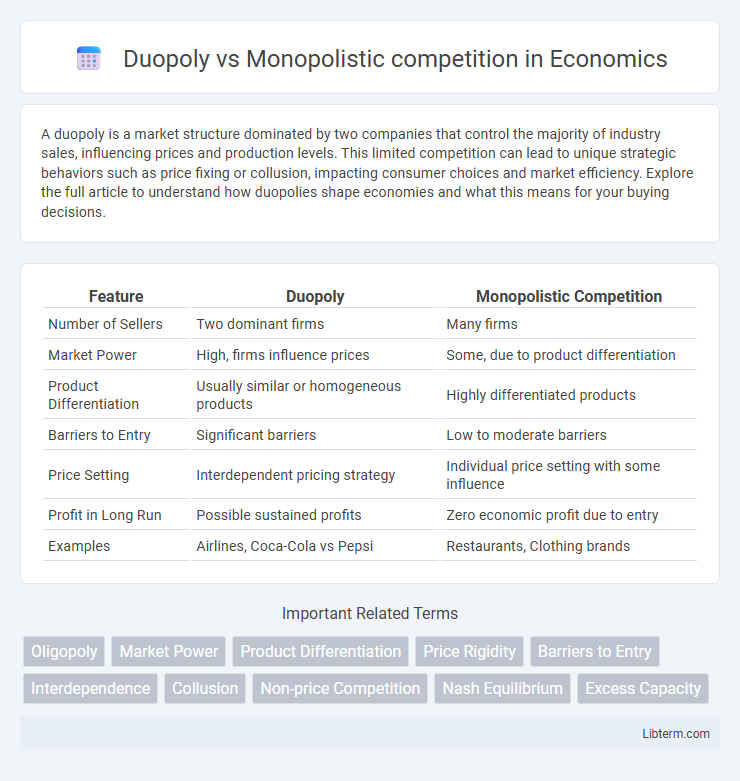A duopoly is a market structure dominated by two companies that control the majority of industry sales, influencing prices and production levels. This limited competition can lead to unique strategic behaviors such as price fixing or collusion, impacting consumer choices and market efficiency. Explore the full article to understand how duopolies shape economies and what this means for your buying decisions.
Table of Comparison
| Feature | Duopoly | Monopolistic Competition |
|---|---|---|
| Number of Sellers | Two dominant firms | Many firms |
| Market Power | High, firms influence prices | Some, due to product differentiation |
| Product Differentiation | Usually similar or homogeneous products | Highly differentiated products |
| Barriers to Entry | Significant barriers | Low to moderate barriers |
| Price Setting | Interdependent pricing strategy | Individual price setting with some influence |
| Profit in Long Run | Possible sustained profits | Zero economic profit due to entry |
| Examples | Airlines, Coca-Cola vs Pepsi | Restaurants, Clothing brands |
Introduction to Market Structures
Duopoly and monopolistic competition represent distinct market structures characterized by the number of firms and the level of product differentiation. In a duopoly, only two firms dominate the market, leading to strategic interactions and potential collusion, while monopolistic competition involves many firms offering differentiated products, fostering competitive pricing and innovation. Understanding these structures is critical for analyzing market behavior, pricing strategies, and consumer choice dynamics.
Defining Duopoly: Key Characteristics
Duopoly is a market structure dominated by two firms that hold significant market power, leading to interdependent pricing and output decisions. Key characteristics include high barriers to entry preventing other competitors, strategic behavior such as collusion or competitive rivalry, and limited product differentiation. This creates a competitive environment distinct from monopolistic competition, where many firms offer differentiated products and compete more freely.
Understanding Monopolistic Competition
Monopolistic competition is characterized by many firms offering differentiated products, allowing them to have some degree of price-setting power while still facing competition. Unlike a duopoly, where two dominant firms control the market, monopolistic competition promotes innovation and variety, leading to more choices for consumers. Firms in monopolistic competition experience downward-sloping demand curves due to brand loyalty and product differentiation, impacting pricing and output decisions.
Entry Barriers: Duopoly vs Monopolistic Competition
Entry barriers in a duopoly are significantly high due to the dominance of two major firms controlling substantial market share, which limits new competitors' ability to enter. In monopolistic competition, entry barriers are relatively low since many firms compete with differentiated products, allowing new entrants greater opportunities to join the market. The structural differences in market power and product differentiation directly influence the ease or difficulty of market entry in these two market types.
Product Differentiation and Market Power
Duopoly markets feature two dominant firms exerting significant market power, often engaging in strategic behavior that influences prices and output levels, whereas monopolistic competition involves many firms with limited market power due to a larger number of competitors. Product differentiation in monopolistic competition is typically pronounced, enabling firms to attract niche customer segments through unique features, branding, or quality variations. In duopolies, differentiation strategies are often more aggressive, as firms compete directly to capture larger market shares, leveraging innovation and advertising to create perceived uniqueness while maintaining considerable influence over market prices.
Pricing Strategies in Duopoly and Monopolistic Competition
Pricing strategies in a duopoly often involve interdependent decision-making where firms closely monitor and react to each other's prices, often leading to price wars or tacit collusion to maintain market share and profitability. In monopolistic competition, firms have more pricing power due to product differentiation, allowing them to set prices above marginal cost while still competing on quality, brand, and features to attract loyal customers. The strategic pricing in duopolies typically revolves around game theory models like Cournot, Bertrand, or Stackelberg, whereas monopolistic competition pricing leverages market segmentation and product uniqueness to optimize demand and maximize profits.
Short-Run and Long-Run Equilibrium Outcomes
In short-run equilibrium, a duopoly typically results in strategic interdependence where firms may earn positive economic profits due to limited competition, while monopolistic competition allows individual firms to earn profits by differentiating their products despite many competitors. In the long run, duopoly firms often face competitive pressure that drives profits to zero or near zero as rivals adjust output or pricing strategies, whereas monopolistic competition sees entry and exit of firms erode economic profits, leading to zero-profit equilibrium with excess capacity. Both market structures exhibit inefficiencies, but monopolistic competition tends to result in a greater variety of products and some degree of allocative inefficiency, while duopoly outcomes depend heavily on firm collusion or competition intensity.
Efficiency and Welfare Implications
Duopoly markets often exhibit higher efficiency than monopolistic competition due to fewer firms leading to greater output and lower prices, which enhances consumer welfare. Monopolistic competition tends to produce excess capacity and allocative inefficiency as numerous firms differentiate products yet fail to achieve optimal scale economies. Welfare implications reveal that duopolies can approach socially optimal outcomes better, though potential for collusion exists, whereas monopolistic competition promotes variety at the cost of increased inefficiency and deadweight loss.
Real-World Examples and Case Studies
Duopoly markets such as Boeing and Airbus exemplify intense competition with high entry barriers and significant market control, driving innovation in the aerospace industry. Monopolistic competition is evident in the fast-food sector, where brands like McDonald's, Burger King, and Wendy's differentiate through branding and product variety despite similar pricing structures. Case studies of these market structures reveal strategic pricing and marketing tactics that influence consumer choice and industry dynamics.
Conclusion: Comparing Duopoly and Monopolistic Competition
Duopoly markets feature two dominant firms with significant market control, resulting in strategic interdependence and limited product variety. In contrast, monopolistic competition comprises many firms offering differentiated products, leading to higher competition and greater consumer choice. While duopolies may restrict output and inflate prices, monopolistic competition promotes innovation and more moderate pricing due to competitive pressure.
Duopoly Infographic

 libterm.com
libterm.com